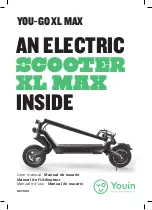
61/269
•
Before each use, check that the front and rear brakes are in
perfect working order.
•
The right lever activates your rear brake. The left lever activates
the front brake.
•
It is recommended that you distribute your braking force
approximately 60/40 between the front and rear. The brake lever
should not be in contact with the handlebars, and the sheaths
should not be bent at right angles so that the cables can slide
with a minimum of friction. Damaged, frayed or rusty cables must
be replaced immediately.
WARNING!
In rain or damp weather, braking distances are longer. It is
recommended to anticipate braking in this situation. There is a
risk of burning yourself if you touch the brakes after prolonged or
intensive use. The brakes may become hot during use. Do not
touch them after using your scooter.
•
When turning and braking, the handlebar can have a negative
influence on the response time of the rider.
1.
Mechanical disc brake adjustment
•
The pads exert pressure on a disc attached to the wheel hub.
The intensity of the pressure is controlled by a lever connected
to the brake by a cable. Do not operate the brake lever when the
wheel is detached from the frame or the fork.
•
If the brake is too tight or too loose, it is necessary to adjust the
brake cable to align the caliper with the brake disc.
•
To align the mechanical disc brake caliper, loosen the fixing
screws of the brake caliper support. Brake with the
corresponding brake lever (the brake caliper is positioned
correctly) and hold the brake lever in this position while tightening
the caliper bracket fixing screws.
•
Check that the internal pad (inside the wheel) is at 0.2 - 0.4 mm
from the disc. If this is not enough, tighten the pad positioning
screw until a gap of 0.2 - 0.4 mm between the pad and the disc
is obtained.
Summary of Contents for KICKWAY E1
Page 263: ...263 269...
Page 264: ...264 269...
Page 265: ...265 269...
Page 266: ...266 269...
Page 267: ...267 269...
Page 268: ...268 269...
















































